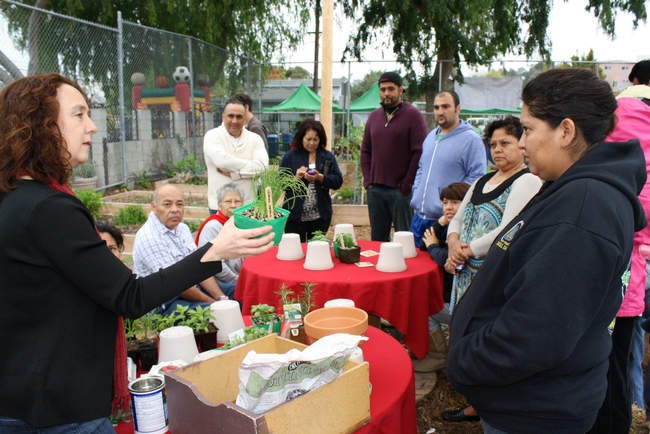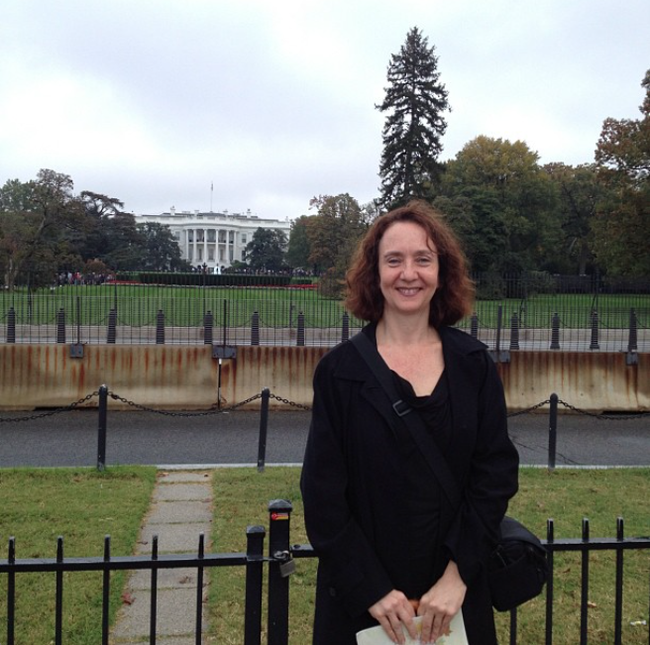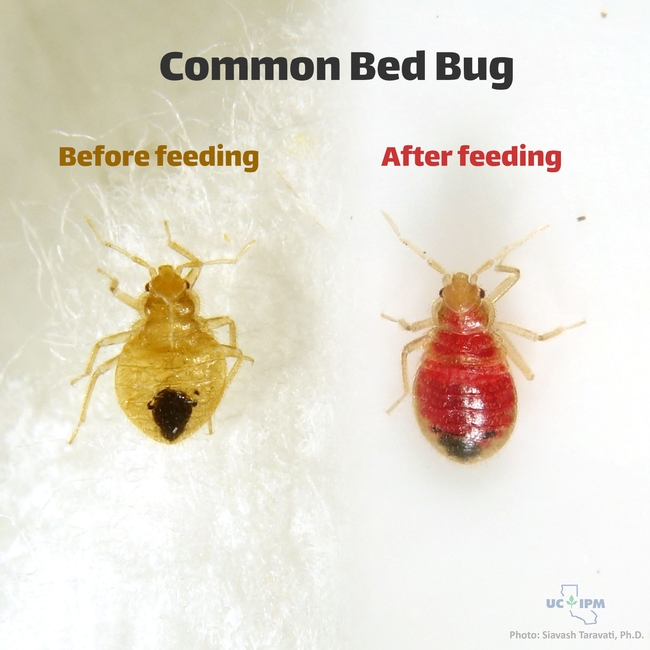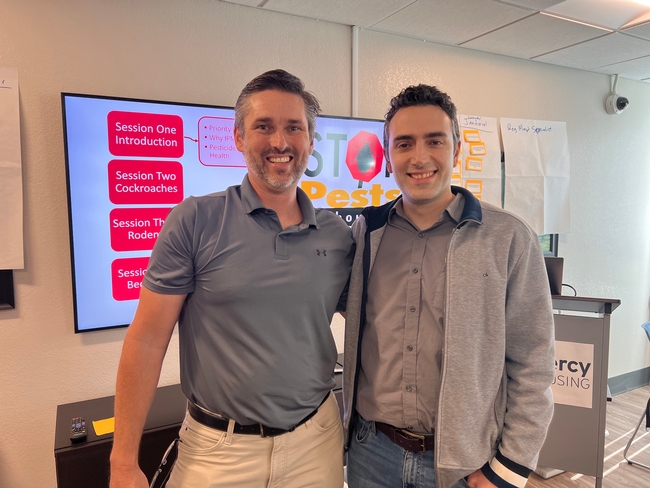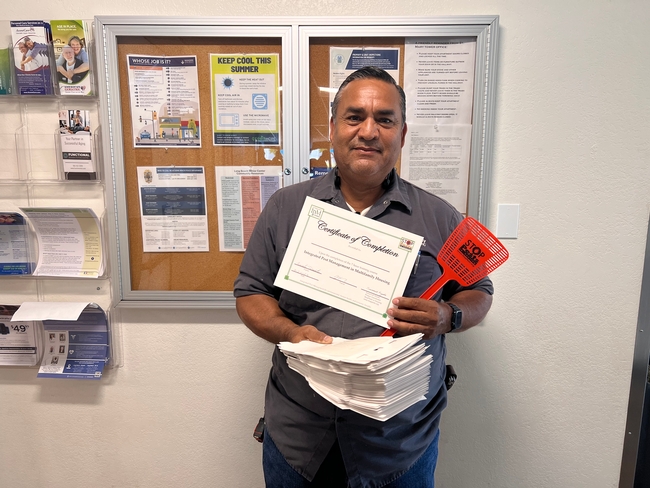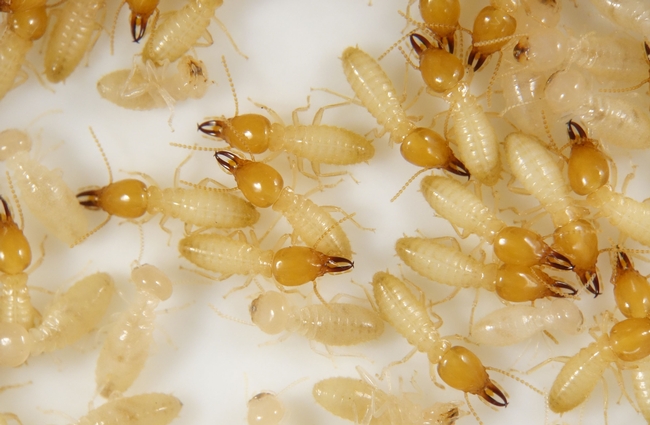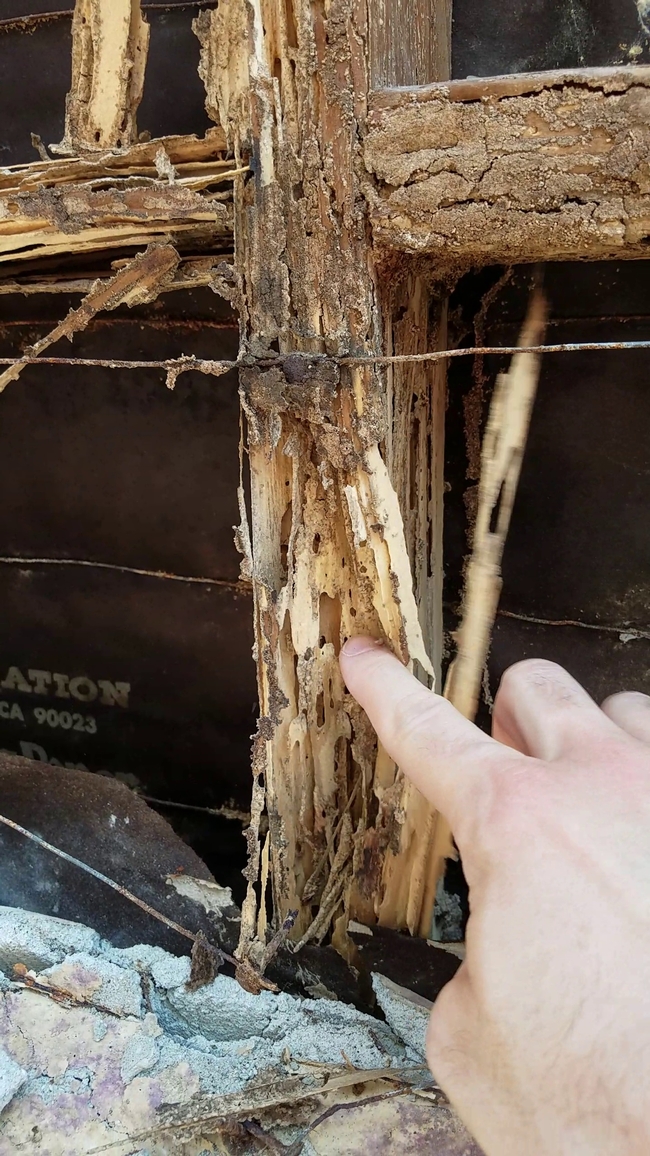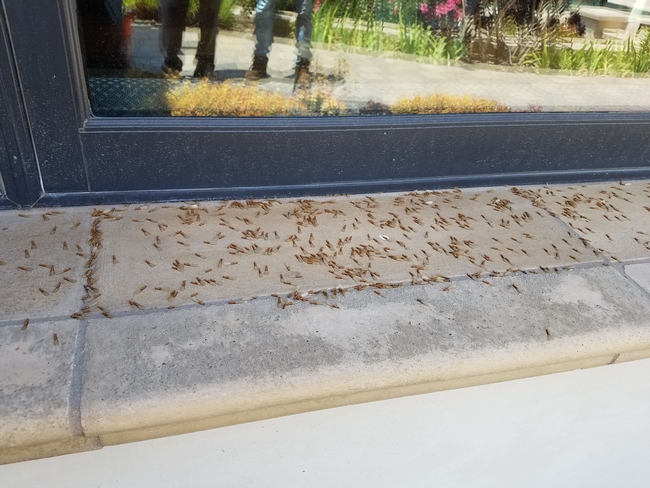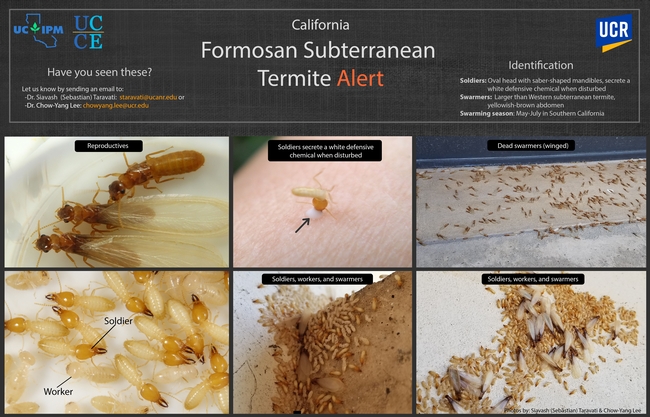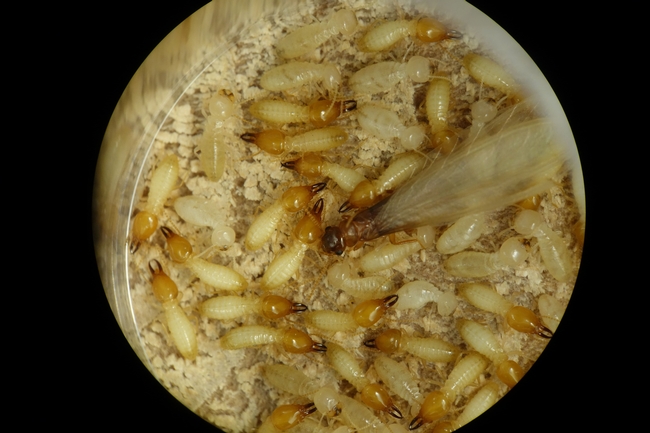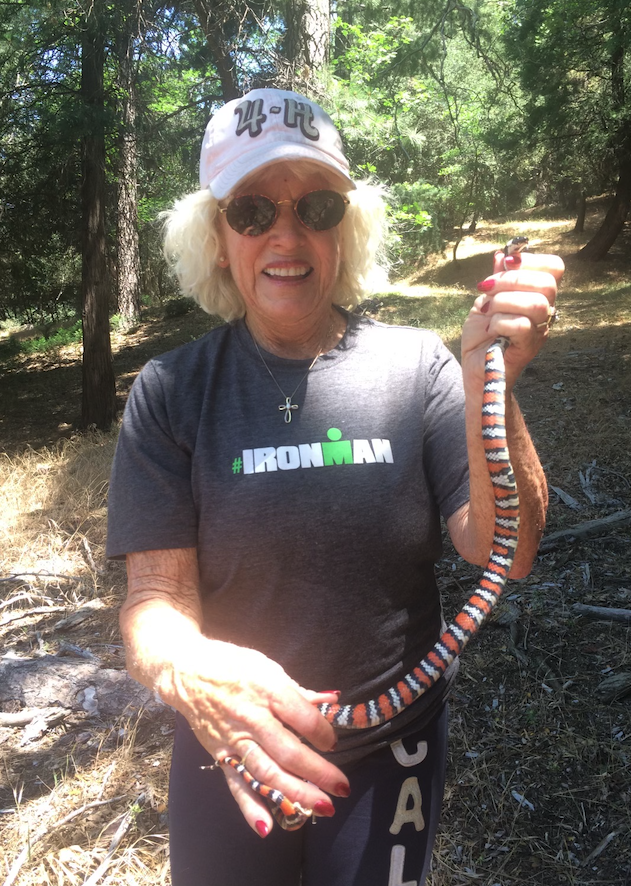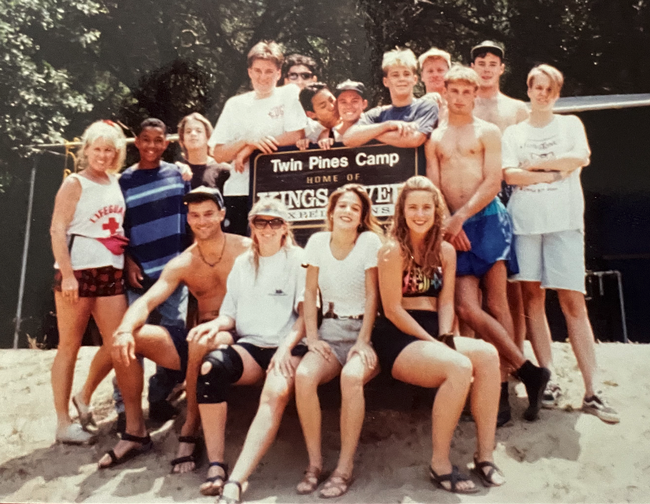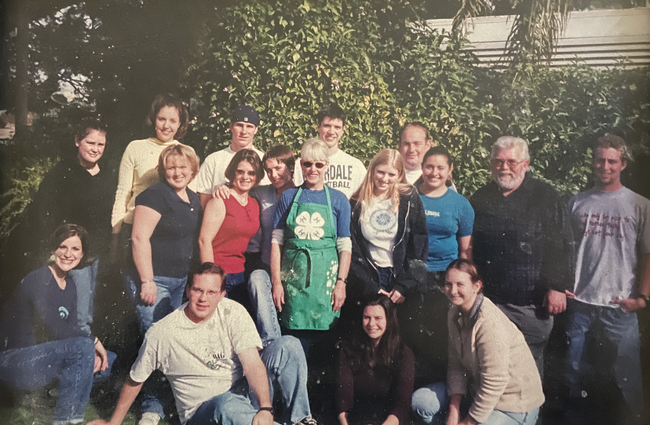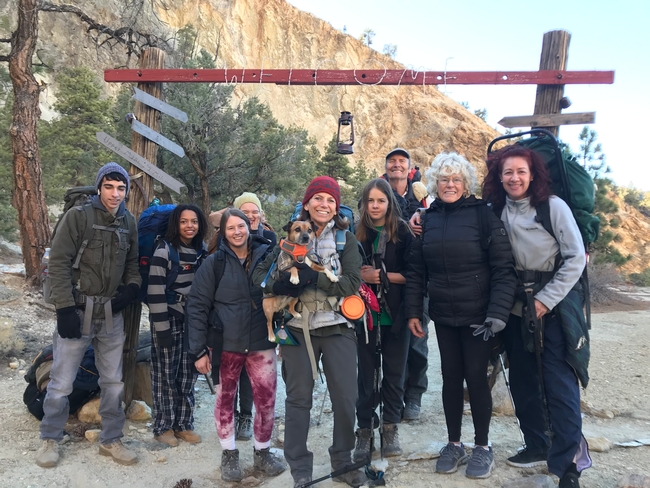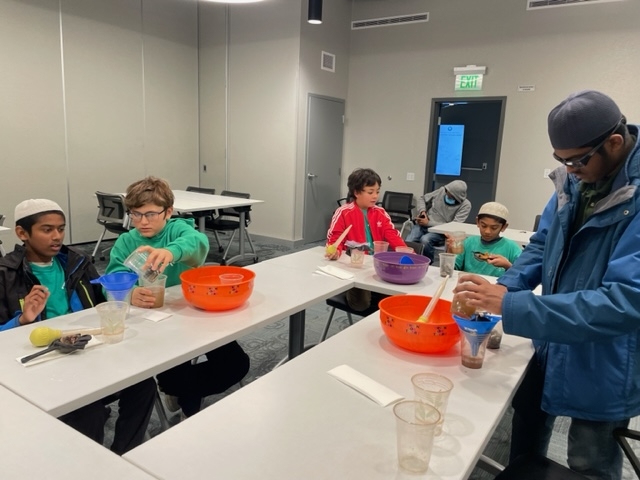Posts Tagged: Los Angeles
Rachel Surls has cultivated a healthier LA County through gardens
UC Cooperative Extension advisor who promotes school gardens, urban agriculture to retire after 35-year career
A stroll through a leafy, green garden can give one temporary relief from life's harshness. During her career, Rachel Surls has used gardens to cultivate healthier communities, whether they are growing nutritious food or providing science lessons for students.
Over the past 35 years, Surls, University of California Cooperative Extension sustainable food systems advisor in Los Angeles County, has witnessed many changes – such as promoting public events on Instagram rather than typing and mailing press releases. A comforting and consistent presence has been the UC Master Gardener Program, part of UC Agriculture and Natural Resources.
“As I look back, the UC Master Gardener Program has been a constant in my work. It helps so many people,” said Surls, who joined UCCE as a school and community garden coordinator in 1988.
“My new job with UCCE-LA was my dream job. I organized community gardens around the county and supported teachers who wanted to start school gardens,” recalled the Michigan native, who plans to retire at the end of the year. “I had a bachelor's degree in agronomy and was freshly out of a stint with the U.S. Peace Corps in rural Honduras. My work there inspired me to pursue community development work related to gardening.”
Louisa R. Cardenas, trustee of Los Angeles County Natural History Museums, was a UC Master Gardener volunteer for 25 years.
“Among Rachel's many skills and assets are her willingness to listen to and consider ideas from Master Gardeners that eventually reach and empower Los Angeles County residents to grow food that supplements their nutritional needs,” Cardenas said.
To complement the nascent UC Master Gardener Program in Los Angeles County, Surls organized “Gardening Angels,” a cadre of volunteers to work with teachers and students to develop school gardens. She edited a guide for teachers, parents and volunteers to build gardens for children.
“I met Rachel in 1992 and was so blessed to come up through the ranks with her,” said Rose Hayden-Smith, UCCE emeritus advisor in digital communications in food systems and extension education. “We were in neighboring counties, and had many similar programmatic interests, including school gardens. Her research informed my work and was so helpful to me.”
Advancing food security, community nutrition
In 1994, after earning her master's degree from Cal Poly Pomona in agricultural science with a focus on agricultural education, Surls accepted a newly created position: UC Cooperative Extension urban horticulture advisor.
To retain Los Angeles County funding in 1992, the UCCE staff had become part of the county's Housing Authority/Community Development Commission. As the UCCE urban horticulture advisor, Surls was tasked with developing gardens at five public housing sites. At one of these locations, Carmelitos Housing Development in Long Beach, she worked with community partners to select landscape trees, hire a greenhouse contractor and design a horticulture job training program for public housing residents. This site became known as the Growing Experience Urban Farm.
“I'm pleased that 29 years later, the Growing Experience is still an active community farm where UC Master Gardeners offer workshops for the community,” Surls said.
In 1997, when George Rendell retired as director of UCCE in Los Angeles County, Surls applied for the job. For the next 14 years, she oversaw more than 70 employees and local programs, including the 4-H youth development program, which launched afterschool, hands-on learning for children.
Surls, who participated in 4-H herself as a child, worked closely with 4-H funders. She helped secure grants, contracts and gifts for 4-H as well as the UC Master Gardener Program and UCCE nutrition programs for projects that encouraged Angelenos to eat more fruits and vegetables.
“Rachel was incredibly creative and innovative as a leader,” said Hayden-Smith, who served as director of UCCE in Ventura County. “Rachel models a kind of quiet leadership that invites people into the process, honors the group and moves work forward in important ways.”
While working, Surls earned her Ph.D. in higher education administration at Claremont Graduate University in 2008, with an eye on pursuing other leadership roles. Instead, the global financial crisis inspired her return to working directly with Los Angeles County residents on urban gardening to reduce food insecurity.
To focus on outreach, the UCCE sustainable food systems advisor handed her UCCE director duties to Keith Nathaniel, UCCE 4-H advisor, at the end of 2011.
Developing, sharing resources for urban farming and gardens
In 2012, she organized colleagues within UC Agriculture and Natural Resources and community partners to study the needs of urban farmers and begin offering workshops for them. She led the development of an urban agriculture website, with resources covering business management, food safety, marketing and regulations. She served on the leadership board of the Los Angeles Food Policy Council and began advising cities on policies that would make it easier for residents to grow food.
“These have been my favorite and most productive years of my career,” Surls said.
Drawing on skills she began honing as an undergraduate at Virginia Tech as a news writer for the Virginia Extension Service, Surls co-authored a book about the history of agriculture in Los Angeles County, called “From Cows to Concrete: The Rise and Fall of Farming in Los Angeles.” She is currently working on a second book about urban farming in the U.S.
The Grow LA Gardens Initiative – which helps aspiring gardeners start their own gardens quickly – is one source of pride for Surls. Hundreds of people have taken the four-week course and, after participating, nearly 70% planted gardens.
In 2018, Surls was honored with the Bradford-Rominger award by the Agricultural Sustainability Institute at UC Davis for her work promoting community gardens, school gardens and urban agriculture.
With community gardens and school gardens now commonplace, Surls chuckles as she recalls veteran UCCE colleagues advising her to choose a more “serious” academic focus early in her career.
“It's gratifying to see so many people in academia working on farming in cities, school gardens and community gardens,” Surls said.
Advocating for equity
In 2022, while Surls was on sabbatical, she and Cardenas – the longtime UC Master Gardener volunteer – requested and received $100,000 from the Los Angeles County Board of Supervisors to hire an equity, diversity and inclusion coordinator and to fund outreach. This UC Master Gardener project championed by Supervisor Sheila Kuehl specifically reaches underserved populations within the county. “Such a significant achievement would not have been possible without Rachel's encouragement and support,” Cardenas said.
After she retires, Surls plans to volunteer her expertise for online training of UC Master Gardener volunteers statewide. To support their program efforts including outreach to the Spanish-speaking community and scholarships for underserved communities, Surls has pledged to give $5,000 as a matching gift to donations to the UC Master Gardener Program in Los Angeles between Giving Tuesday, Nov. 28, and Dec. 31 at https://ucanr.edu/LAmastergardener.
UC Cooperative Extension advisor helps property managers prevent pests in the home
Living with pests, or “unwanted guests” as some put it, can take a physical, mental and economic toll. For people living in multi-family unit housing, like an apartment complex where everyone lives under one roof, a single infestation of insects or rodents can expose all residents.
Using integrated pest management, or IPM, residents and property managers can detect infestations early and control severe ones and protect people. IPM programs can also save money. IPM saved a 75-unit complex in Contra Costa County $11,121 annually. Similarly, in Santa Clara County, a 59-unit complex saved $1,321 on pest control annually after implementing a proactive IPM program.
This summer, regional directors, property managers, residential service coordinators, maintenance managers and groundskeepers of Mercy Housing – a nonprofit organization that provides affordable, low-income housing – gathered in Long Beach to learn about in-home IPM. The session was led by Siavash Taravati, University of California Cooperative Extension area IPM advisor for Los Angeles, Orange, Riverside and San Bernardino Counties, and
Josh Shoemaker, an entomologist and private consultant.
Taravati and Shoemaker collaborated with StopPests in Housing, a national program out of Cornell University's Northeastern IPM Center, which seeks to improve pest control in affordable housing and teach management practices for cockroaches, bed bugs and rodents within and around the home.
During their presentation, Taravati introduced participants to the IPM principles and emphasized the importance of monitoring pests.
“IPM is all about making informed decisions which requires knowing the latest status of an infestation,” explained Taravati. “That's where monitoring comes into play. It can help us to identify the exact species we are dealing with as well as telling us if an infestation is growing or shrinking.”
“Monitoring is foundational,” agreed Shoemaker. “If a program does not include monitoring, it's not an IPM program.”
According to Shoemaker, the benefit of partnering with UC IPM is their sharp focus on general IPM, which includes monitoring. “It's real IPM, that prioritizes the well-being of the public,” said Shoemaker, who's eager to continue working with Cooperative Extension and Taravati to ensure that children are growing up in safe environments.
Pest control treatments commonly take place following a serious infestation or several complaints, but IPM promotes constant monitoring to prevent heavy infestations from ever happening. It's a proactive approach rather than a reactive or emergency-response. For many attendees, the training revealed a need to engage with pest management operators more closely.
Training prompts changes that improve safety for residents
Pest management operators commonly use pesticide sprays to control pests. Besides inconveniencing residents, forcing them to do extensive preparations and evacuate their unit until it's safe to return, sprays increase exposure risk to pesticides since the aerosols can linger and land on surfaces.
Instead, Taravati and Shoemaker recommend using gel baits, which are much safer to apply and can target a specific area of a home, including crevices, instead of along all the walls.
“Now that I'm more informed, I'll be speaking to my contractor to discuss how we can switch their approach from a bug spray to a gel,” said Leonardo Pinuelas, a maintenance manager for Mercy Housing.
Pinuelas is not the only one wanting to modify their program, however. According to feedback from staff members at the Housing Authority of the City of Los Angeles who experienced the same training earlier this year, they prompted their team to amend their pest extermination to include dusting, or applying insecticidal dusts, against roaches, and to review and update their existing IPM plan and practices where appropriate.
Cindy Wise, area director of operations for Mercy Housing, said that in her 35 years, this was one of the few trainings that engaged her staff so actively. “I couldn't help but text my regional vice president to say that our managers were actively participating and asking questions. That doesn't happen often, not even in our own meetings,” said Wise.
Many of the attendees, with their new understanding of how cockroaches move through a structure, shared that they are eager to return to work to meet with residents and support them.
“If you've got roaches in one unit, you've got them in the entire building,” Wise said.
Shoemaker recalls the words of Judy Black, senior technical entomologist for Orkin, and Dini Miller, entomologist at Virginia Tech, who urge the importance of inspections and documentation as IPM best practices.
Although reporting pests in the home can make one feel embarrassed, Wise said she is more interested in making residents feel empowered to not only report signs of infestation to the staff, but to their neighbors.
Training residents is certainly beneficial, but as experts such as Black and Miller have pointed out, housing managers must do their part, instead of scapegoating tenants for their cleaning habits.
StopPests provides free IPM training and technical assistance to Housing and Urban Development assisted properties. If you are interested in the training provided by Taravati and Shoemaker, in collaboration with StopPests, visit StopPests.org for more information.
Cooperative Extension advisor, UC experts tackle ‘nightmare’ termite
During summer swarming season, homeowners urged to check for signs of Formosan subterranean termite
In the lottery of troublesome termite infestations, “Roger,” a Rancho Santa Fe homeowner, hit the jackpot (a pseudonym is used to protect his privacy). In 2021, his house in San Diego County was identified as home to only the fourth documented colony of the Formosan subterranean termite (Coptotermes formosanus) in California.
“FST is one of the most destructive urban pests in the world,” said University of California, Riverside entomologist Chow-Yang Lee, affiliated with UC Agriculture and Natural Resources through the campus' Agricultural Experiment Station. “It's also the only termite species listed in the ‘100 of the World's Worst Invasive Alien Species.'”
Endemic to East Asia, this termite is now established in many tropical and subtropical regions, including across the American South. Annually, its infestation costs more than $4 billion in control measures and damage repairs of structures in the U.S.
FST was first discovered in California in La Mesa (San Diego County) in 1992, and it was rediscovered in that city in 2018. Another infestation was reported in Canyon Lake (Riverside County) in 2020. And then, the following year, Roger received his surprise.
“Imagine being in your kitchen looking at your drywall and it's totally normal and then the next day there's a four-inch hole there and you're like ‘What the heck is that? Who put their elbow into the drywall?'” he recalled.
FST colonies can reach millions of individuals
Roger hired a pest control company, Green Flash Pest Control, which sprayed a powerful liquid termiticide in the soil around the house. But the termites – workers, soldiers and winged “alates” – continued to appear. The company tried a second application of soil treatment. But, again, the termites kept popping up.
“We were deeply concerned about the potential damage these termites could cause to the home since these invasive termites are extremely destructive,” said Eric Veronick, director of operations at Green Flash. “Unfortunately, there isn't a whole lot of information available on the behavior and management of this termite in California.”
The company called upon Siavash Taravati, a UC Cooperative Extension urban Integrated Pest Management (IPM) advisor based in Riverside.
“Some colonies are aerial, meaning that they are formed above the ground with limited or no connection to the soil – in such cases, soil treatment using contact insecticides may not be very effective in managing these termites,” Taravati said. “Furthermore, contact insecticides usually kill a much smaller portion of the colony when compared to termite baits.”
To make matters worse, once FST is established in an area, there have been no records of successful eradication anywhere in the world, according to Taravati. He added that a major reason why the Formosan subterranean termite is so destructive is the enormous size of their colonies.
“Their colonies can reach millions of individuals, versus most native subterranean species that reach a few hundred thousand individual termites per colony,” Taravati explained.
This termite, through its sheer numbers, can turn the wood in a structure into a “spongy kind of cake,” in Taravati's words. More than 10 pounds of wood in a house can be eaten by a mature colony each month. The financial hit for a homeowner can be substantial, up to tens of thousands of dollars – not to mention the increased risks to safety.
“Anything from studs to rafters to door frames and window frames – everything is going to be compromised, if the termites are left unchecked. And then, as soon as we have a major stress on the building, let's say there's a big storm or an earthquake – there's a high risk of at least part of the building collapsing,” said Taravati, who also noted that, unlike California native subterranean termite species, FST can attack and kill live trees and plants.
“These termites can be a nightmare,” he said.
Summer is ‘swarming season' for FST
Since the Rancho Santa Fe case in 2021, four more colonies have been documented, in La Mesa again and also in Highland Park, Hollywood Hills and La Verne (the latter three in Los Angeles County). Taravati said it's possible that FST has been spreading via structural lumber or potted plants and soil.
And even if a colony appears to be eliminated at a certain locale, Taravati noted, there is always the chance that part of the colony survives or more colonies of termites already have been established in nearby locations, as a result of swarming termites from the originally infested property.
Although nominally “subterranean,” certain members of an FST colony grow wings and fly to nearby locations to establish new colonies. These winged alates are also called swarmers because of their behavior during the “swarming” season, when termites mate and reproduce.
For the Formosan subterranean termite, that swarming season in California is late May through early August, so now is the time for homeowners and building managers in southern and central California to keep an eye out for those winged termites.
“If you experience a termite swarm in your house, contact a pest management professional and keep some termite samples in a Ziploc bag in the event you need to send the samples to UC Riverside for morphological and DNA-based identifications,” said Lee, who added that it's a good idea to periodically check your structure for signs of infestation, such as wood damage or shelter tubes (mud tubes).
Lee said FST swarmers have a lighter colored body compared to the dark color of native subterranean termites and the orange-brown body of drywood termite swarmers (see this flyer for additional identification information).
Following an especially wet winter, there's a chance California could see more FST infestations, as this termite generally requires moist environments to thrive, Lee added. He recommends that concerned community members seek professional advice.
“Do not attempt to control an FST infestation by yourself,” Lee said. “This is not your typical native Californian subterranean termite species; they are highly destructive, and you want to intercept the problem with the right strategy before it's too late.”
Homeowner: ‘I owe them my house'
In Roger's case, Taravati enlisted the help of Lee and his UC colleague, Greg Kund. They made multiple visits to inspect the home and analyze the situation – going “above and beyond,” according to Roger.
At Lee's suggestion, they used a caulk gun to insert a gel-like experimental bait into the wall where the termites were coming out. Once spread and passed on to the other nestmates, the product – which contains a chitin synthesis inhibitor (a type of insect growth regulator) – interrupts the termites' development so they are unable to properly molt and replace the short-lived “workforce” of foragers and soldiers. The colony eventually collapses and is eliminated.
“Generally speaking, IGRs are much more effective, but they require more patience,” Taravati explained. “You're not going to see the results the next day, or two-three days. You're going to see the results in a few weeks – but when you see the results, it's massive.”
And that's exactly what Roger and Green Flash Pest Control saw.
“Soon after their bait application, the termites stopped emerging from the walls and that gave us and the homeowner a big sigh of relief,” Veronick said. “I appreciate their expertise and dedication in helping us get rid of this destructive pest."
Roger said he is immensely grateful to the UC team.
“They were fantastic; I owe them my house,” he said. “They were super gracious and helpful and responsive and – ultimately, the thing I care most about – they were effective; they fixed the problem. Here we are two years later and – knock on wood, or maybe I should knock on something else! – everything is good.”
Lee also credited Taravati for bringing his knowledge and “can-do” attitude to communities across Southern California.
“He is highly knowledgeable and always able to come up with feasible solutions,” Lee said. “We need good Cooperative Extension urban IPM advisors like Siavash who could provide good advice and bring solutions to the stakeholders, be they homeowners or pest management professionals.”
Taravati said community members need to maintain their vigilance and urges them to download and share the FST flyer that includes identification tips and contact information. He said they are always free to e-mail him with their concerns and photos of suspected FST – not only to help stop the spread of the pest but to expand scientific understanding.
“This termite is so new to California – even for us, as researchers. Despite being in La Mesa since the 1990s, it wasn't until 2020 when these termites were detected in other places, including Riverside and Los Angeles counties,” Taravati explained. “All of us need to learn more about this pest and closely monitor the behavior of this pest.”
4-H volunteer of 48 years is more motivated than ever
A typical day for Dee Keese starts with a 10-mile walk at 5 a.m. and her morning wraps up with a swim. Although Keese is in her late 70s, her daily routine would not surprise you if you knew what she has been doing for the last 48 years.
For nearly a half-century, Keese has been the 4-H community leader for the Palos Verdes Peninsula (PVP) club in Los Angeles County. A youth development program managed through local University of California Cooperative Extension offices, 4-H uses hands-on learning experiences to empower youth to build self-esteem and connect with their communities as emerging leaders.
“When you're pushing 80, working with young people helps to keep you young,” Keese said.
4-H has been a game changer in many ways
In the 1970s, Keese moved to the Palos Verdes area with her first-born son who had a learning disability. Others treated him differently in school, and it didn't help that he was the new kid in town. A neighbor encouraged Keese to enroll her son in 4-H.
“She told me, ‘You've got to put your son in 4-H so he can feel good about himself,'” explained Keese. “And let me tell you, it changed my life.”
In 1978, two weeks before her fifth child was born, Keese became the 4-H PVP club's community leader and has been in the role ever since.
While reflecting on her earlier days with 4-H, Keese remembered when most members were boys. Girls were not intentionally excluded at the time; clubs just didn't attract them. When girls eventually joined 4-H, it was a game changer.
“All of a sudden, the program shifted focus from solely agriculture and animals to include home economics like cooking and sewing,” Keese said. “Now, all my sons do the cooking in their homes. It's a good thing! Because we're moving away from traditional domestic duties, men and women are sharing roles, as they should be.”
The PVP 4-H club offers activities like archery, sailing, surfing and geocaching. “Everything we do is to help our youth be better as adults, out in the real world and in the workforce,” said Keese. “We're relying on the internet too much. Kids need to get outside and do things.”
Over the years, Keese has taken members – who range in age from 5 to 19 – on numerous hikes in places like Havasupai Indian Reservation and Mt. Whitney. She's taken them kayaking on the Colorado River and, these days, co-hosts old-fashioned card game nights on the weekends with other community members.
As a lifeguard and water safety instructor, Keese gives free training to interested 4-H members to become lifeguards. Training courses usually cost well over $200 per person. “If they're interested, I train them and they have another skill to use. And it benefits our club,” said Keese. “When we have pool parties or beach days, my kids are prepared to step in and help.”
‘She will help anyone and everyone at any time'
Ace Yeck, former president of the PVP 4-H club, met Keese 12 years ago and decided to become a 4-H member when he was in fourth grade, following a convincing conversation with her. “She just kept giving me opportunities,” said Yeck.
Currently a third-year undergraduate at Loyola Marymount University studying entrepreneurship, Yeck credits 4-H for preparing him for college. “I got all my community service and public speaking practice through 4-H. I remember doing beach clean-ups, feeding the homeless, helping out at the Christmas fair, and all kinds of events,” he shared.
During his years with 4-H, Yeck was elected to the state board as an ambassador before he went on to represent 4-H at the national level. “Dee encouraged me every time, so I kept going,” he said.
Keese admitted that her life is so full and fun because of 4-H. Her motivation stems from the growth and progress that her students experience. “My kids let me know when I've done something to impact their life. It keeps me motivated,” she said.
While thinking about the members she's had over the last 48 years, she couldn't help but stress how important it is that they feel safe. Keese recalls one student who is gay and had a challenging time getting his parents to understand because of religious and cultural barriers. “The family's priest called me and told me that this student felt like I was the only one who loved him,” she said.
“I can talk about Dee forever,” said Yeck. “One of her best qualities is that she will help anyone and everyone at any time. She wakes up at 5 a.m. and goes to bed at, like, 10 p.m. During that time, she's always helping people,” he added.
Because Keese comes from a different generation compared to the kids in her 4-H club, she attributes her successful impact to her ability to adapt. “If we want to keep kids in this, we've got to be flexible! And you've got to do things they like. We can't do things the way it's always been done before,” said Keese. “We have to be flexible.”
To Keese, 4-H is not just an opportunity to teach life skills or introduce kids to agriculture. It's a chance for them to build community.
“That's what I think my generation does well, having grown up in the '50s and '60s,” Keese said. “We're all about that communal living.”
Los Angeles 4-H program cultivates future generation of water stewards
Ibrahim Yaaseen, member of the Palos Verdes Peninsula (PVP) 4-H club, grabs a hard hat and places it on top of his head. He then reaches for a bright orange safety vest and goggles to complete his safety gear outfit before joining the rest of his club members who are dressed the same.
The 4-H Youth Development Program of Los Angeles is already thinking about the future of water management and turned to the West Basin Municipal Water District in El Segundo to gain a deeper understanding of the precious resource we often take for granted.
The University of California 4-H Youth Development Program is managed through local Cooperative Extension offices. Through hands-on learning experiences, 4-H empowers youth to reach their full potential and enables them to build self-esteem, connect with their community and emerge as leaders.
Dee Keese, community club leader for the PVP 4-H club, coordinated an exclusive and interactive tour of West Basin's Edward C. Little Water Recycling Facility for the club's monthly marine biology meeting in December 2022.
Eager to inspire a stronger appreciation for water, Janel Ancayan, the West Basin's education coordinator, challenged the youth to build their own water filters using materials including fabric, a strainer, and a funnel. Since no specific directions were given, the activity challenged each student's science and engineering skills, such as carrying out an investigation, designing a solution, and communicating information with team members.
During the tour, students saw firsthand the impressive equipment and essential staff members that help to produce nearly 40 million gallons of recycled water each day. At the end of the day, students left with a deeper understanding of water resources and felt empowered to do their part to conserve water sources.
“We learned that recycling water helps to conserve our limited water supply and improves the environmental condition of our coastal waters,” said Yaaseen. “We ultimately learned a great deal about how to conserve water for future generations and that water conservation is one of the most important elements in combating climate change.”
Though Keese has volunteered as community club leader for 48 years, this is only the second time she has partnered with the West Basin. “I like to mix it up,” she said. “I'm always looking for community organizations and local businesses to partner with because these are places that the kids will likely interact with since they're nearby.”
Regardless, it's leaders like Keese and programs like 4-H that encourage water stewards like Ancayan. “I'm always so humbled and inspired when teachers make it a point to come out and visit our facility. In Southern California especially, [water] is not something we think about,” Ancayan said.
Even in a drought, water continues to flow from our faucets allowing us to shower, wash dishes or water the lawn. It's no wonder why water conservation is not always top of mind, especially for consumers. Educating the public, and targeting the younger generation, however, is a great start to prepare for the future.
West Basin offers a variety of educational programs that focus on different age groups. Many of them involve hands-on learning like the Teach and Test volunteer program, a partnership with the Surfrider Foundation, where high school students test samples of coastal water for bacteria, and then publicly share their findings to contribute to water quality monitoring in the area.
According to Yaaseen, the time spent with Ancayan at the West Basin was “one-of-a-kind” and provided a “golden opportunity” to learn why water recycling facilities are important. Ancayan hopes that her time spent with students ultimately influences them to consider a career in water.
“It's not a glamorous job but I'm really passionate about the next generation of water workers,” she said. “I hope that once they see the engineering, the excitement of these scientists that work in our laboratory and everything in between, that they start to think about water as a future career path.”
For those interested in joining 4-H, visit https://4h.ucanr.edu/Members/
To read this story in Spanish, please visit:
Programas 4-H de Los Ángeles forman a la futura generación de administradores de los recursos hídricos
https://ucanr.edu/blogs/blogcore/postdetail.cfm?postnum=57063

